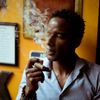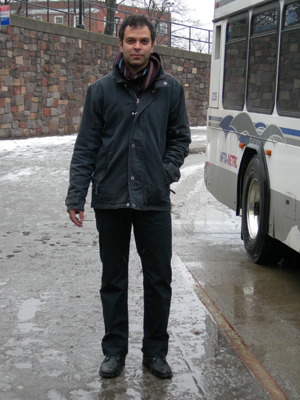
The credits roll and you notice the name of the producer. Stock-in-trade for a film, but what about that role in the world of art? A profile of Asad Raza. An Interview with Hans Ulrich Obrist with notes from artists.
Asad Raza, Buffalo, New York
One way in which Hans Ulrich Obrist describes the art producer is: the person who "solves the scenario" surrounding a given work. But there are no regular media such as rolling credits or names in a program that would start us on a trail to finding out what that means. In fact, the job of art producer defies perfect definition when it is done well.
This is a motivating thing to unravel, since we don't often consider the inner workings of art, preferring to think of it as genius falling from the clouds. But there is a world behind each piece, and I would like to consider one part of it in order to expand our view of what makes art.
WHO IS ASAD RAZA?
Among other things, Asad is an art producer. I met him while working as a participant in Tino Sehgal's exhibition, "This Progress," at the Guggenheim Museum. He interviewed me for the job in a meticulous process that screened hundreds of people over, I guess, hundreds of cups of coffee. Then I watched closely as he trolled the exhibition for three months, consulting with Sehgal on everything from traffic flow to the conversations between the participants and the public. After it was over, I discovered that the intensely organized operation was the result of over a year of planning, and I even caught a glimpse of a monstrous Excel spreadsheet used to manage things all the way down to visitor flow. I'm pretty good at Excel, but this looked like Sanskrit to me.
But there's much more than technical management here. Alia Raza (sister) expands on this notion as she reflects on Asad's work. He produced her film White Light and her video series The Fragile White Blossoms Emit a Hypnotic Cascade of Tropical Perfume Whose Sweet Heady Odor Leaves Its Victim Intoxicated featuring Kim Gordon, Chloe Sevigny and Devendra Banhart.
"Of the independent producers I've worked with, there have been the organized, the energetic, the persistent. Asad can be all of those but most of all he is creative, and that's incredibly rare."
It was this idea of the art producer as an integral creative and conceptual element that kept coming back to me many months after the Tino Sehgal exhibition. Clearly, Sehgal had rendered a masterwork. Behind it, I saw a role that is not much considered in art.
Let's start with history. Though I don't imagine a fade to black followed by a few hundred names appearing behind Rodin's bronze and marble figure, The Thinker, I do imagine a producer for that piece. I stand behind John Donne on this idea, knowing that just as no man is an island, no work stands alone. Someone must clear obstacles for the artist to work and further participate in building context for the viewer. I don't think we would know Rodin as we do today if not for the many "producers" (in his case, fellow artists, politicians, and patrons) who lobbied hard for the proper exhibition of his earlier work, Age of Bronze, defending it as a work solely of his hands and not a cast piece.
Sarah Morris, painter and video artist based in London and New York, weighs in on this point:
The art producer is not a new role in history. Robert Towne [screenwriter for Roman Polanski's Chinatown and subject of Morris' film and portrait Robert Towne] refers to them as those persons who are vital to shaping the work, but who are not essential. The producer's role is one part of bringing art back in from that margin of the lone tortured artist stereotype, but without stripping it of any of its wonder. I'm better able to juggle both the weight and the ambition of the project.
Even with this context, the job is still undefined in art, and that ambiguity is its strength, making the producer a type of artist himself. If we could define it perfectly, we might just corrupt it with a false roadmap for art students or with a new stereotype of "the producer" as we know it in music and film.
So, it fits that the first prerequisite for the job seems to be to live the life of a polymath.
I mean a real one -- not just someone who may be versed in Edward Said's Orientalism and wield a fair hand at mahjong, but who would also be a true dive bar expert (finding it in Texas and becoming welcome there) and fearless at a pickup game in a rough park, going beyond the sheltered intellectual aspects of the human experience. You may also have organized a labor strike and written articles as a regular contributor to Tennis Magazine... Asad.
Another important characteristic is that the art producer doesn't seek to be named. I asked to write this. Asad has a top-tier resume as an art producer, but you won't find much written about that. That's a good design: If we think of anyone when we see the work, it should be the artist. Beyond that, even the artist fades when art is actually achieved. You are confronted with truth and truth has no credits. It just is. Now imagine the scene of being engrossed for any length of time in a moment that brings art that closely to you. That's the ideal.
But, with no artwork in front of us, I enjoy preempting a valid fantasy and coming back to earth to meet a real person who plays a less seen part in the ideal. That is Asad Raza.
HANS ULRICH OBRIST ON ASAD RAZA, ART PRODUCER
Instead of asking Asad to explain further to us, I have asked for comment from people with whom he has worked. I am looking for the alternately aerial and detailed view that can only come from an expert observer of the person Jordan Wolfson calls the "third collaborator, along with the artist and the institution." Wolfson, American conceptual artist now showing at Alex Zachary Gallery, notes that:
[Asad] brings a hyperagency to the process, allowing the artist the freedom and permission to execute his concept in a way that interweaves the institution, the artist and the public by moving in and between both the logistic and conceptual.
To explore the full view, I recur to Mr. Hans Ulrich Obrist, the Co-director of Exhibitions and Programmes and Director of International Projects for the Serpentine Gallery. He is known as perhaps the most influential curator in the art world. However, in the first few minutes of speaking with him, you will quickly be taken beyond a title and, further; you will be hard pressed to comprehend his distinct combination of high volume, high quality, non-stop, highly varied work in the cultural space. Apart from his global curatorial work, he has continued to record thousands of hours of in-depth conversations with leading cultural and art figures from Rem Koolhaas to Jeff Koons in his Conversation Series project. As such he is not only an art voice, but also a venerable voice in modern thought.
Obrist's theme of polyphony resonates as the most relevant frame of mind for our conversation. Generally, polyphony is a musical term describing a particular harmony of simultaneous but independent melodies. For Obrist, it is a robust analogue, whether he applies it to the work of the curator or to the reshaping of urban centers.
To articulate polyphonies (or even to see them) amidst today's ragged counterpoint is a route to the kinds of honest and tough discussions we should have as we find ourselves remaking our cities and political hierarchies in what looks like... a pure mess. These are the voices we should look for, the ones who can find or create that 'swing' in the midst of the coming together of noises. That is Hans Ulrich Obrist.
I had three questions for him. I asked and then hung on tight as I listened: He uses no fillers, speaking discrete content with each sentence and at a very fast pace.
How would you define the role of producer and Asad's work in particular?
The role is invented in the way Asad performs it. Distinctly, a new profession. Asad is not one who just facilitates art work, but he is also an expert tennis critic, an author, a person of broad interests that he dives into deeply and individually, not to master a trade, but perhaps to solve the scenario around a piece of art. Tino's was his biggest and most ambitious project, from the vital role of casting to the organizing of a great complexity of people and materials surrounding it. This was no small thing to situate demands that sometimes may not be in conflict but still in competition because of their intensity. Imagine a child looking at a gigantic slice of birthday cake sitting on the seat of a brand new bike being told to walk past it into the door of an amusement park. Tino's was a great exhibition and example of this, creating many new things, such as the melding of generations of people from 8-100 years old into one work.
Asad's effect is a sustained one as he coordinates disparate scenes. He spends real thought on "matching junctions," down to what some may see as mundane tasks. They are still critical junctions that must be solved for the artist. The work he has done for Sarah Morris, I think speaks to this.
So, he becomes also the prime organizer, the coordinator, the fixer and also a "producer of relationships," managing the interactions between people, and creating meaningful conversations. The result is that artists trust him, not only on the strength of his pragmatism but also for his interest and passion about the mainstream, to be accessible to people. [Obrist says this not in the tone of a standard compliment, but rather as a fact that defines Asad's work and is transmitted in the quality of his work.] Asad elicits a very necessary human touch, whether he is speaking with a curator or with Nadal or Federer about some tennis topic for an article.
How do the roles of producer and curator work together? Is there an overlap there?
The role is perfectly symbiotic with the curator. Consider the 11 Rooms exhibition at the Manchester International Art Festival . It consisted of multiple live experiences, each created behind a private door allowing the visitor to personally encounter a given situation in the form of human sculpture. Asad produced Tino Seghal's piece "Ann Lee" for 11 Rooms and he was a complex and integral part of the entire collaboration.These are 21st century skills. I think of the art producer in the context of Joseph Beuys expanded notion of art, in which curating also resides. You are familiar with producers of cinema, but now consider the interdisciplinary work of not just connecting things but also connecting honestly to people. This is not only the rendering of a service but a connected extension of the curator. This job is not a standard role in art and that is the exhilarating part of it.
How would you describe the evolution of a producer? Are there some necessary experiences that would lead someone to this kind of work?
You cannot predict or map the steps into some plan. It's a multifaceted thing moving in a non-linear practice, drawing together disparate things that don't normally come together. Art, things, people, circumstance, urgencies formed into unified pieces that are relevant and sustainable. These have the best chance of standing the test of time.What strikes me about Obrist and the artists' comments is that they are uncoordinated between them, but each one is a solid meditation whose logic and sentiment flows with the other two comments and with what we have discussed up to this point.
SYNTHESIS
Obrist refers to the art producer being in the business of the "production of reality." That sends me back to his polyphony concept, as the thought of that refers directly to the myriad ways that individual persons and the whole environment can be coordinated and then of the way they must be coordinated for things to work.
As we speak, Asad is in the midst of yet another intricate exercise. He is working on Tino Sehgal's largest project to date, scheduled to take place during the London 2012 Cultural Olympiad and to be featured as the flagship work, to premiering in the five-storey, 3,400 square meters of Turbine Hall at Tate Modern.
As observers, we live for that, to be witnesses to that certain 'swing.' It can be as personal to you as to encounter a piece all by yourself and be taken away in awe or invaded by a feeling. That's what art can do -- cliché until you experience it. No single person can be charged to create that, but I believe, nearly by definition, that the ghost of this polyphony relentlessly haunts the art producer, often a ghost himself.

